air condition RENAULT TWINGO RS 2009 2.G Heating And Air Conditioning - Climate Control Repair Manual
[x] Cancel search | Manufacturer: RENAULT, Model Year: 2009, Model line: TWINGO RS, Model: RENAULT TWINGO RS 2009 2.GPages: 99
Page 91 of 99
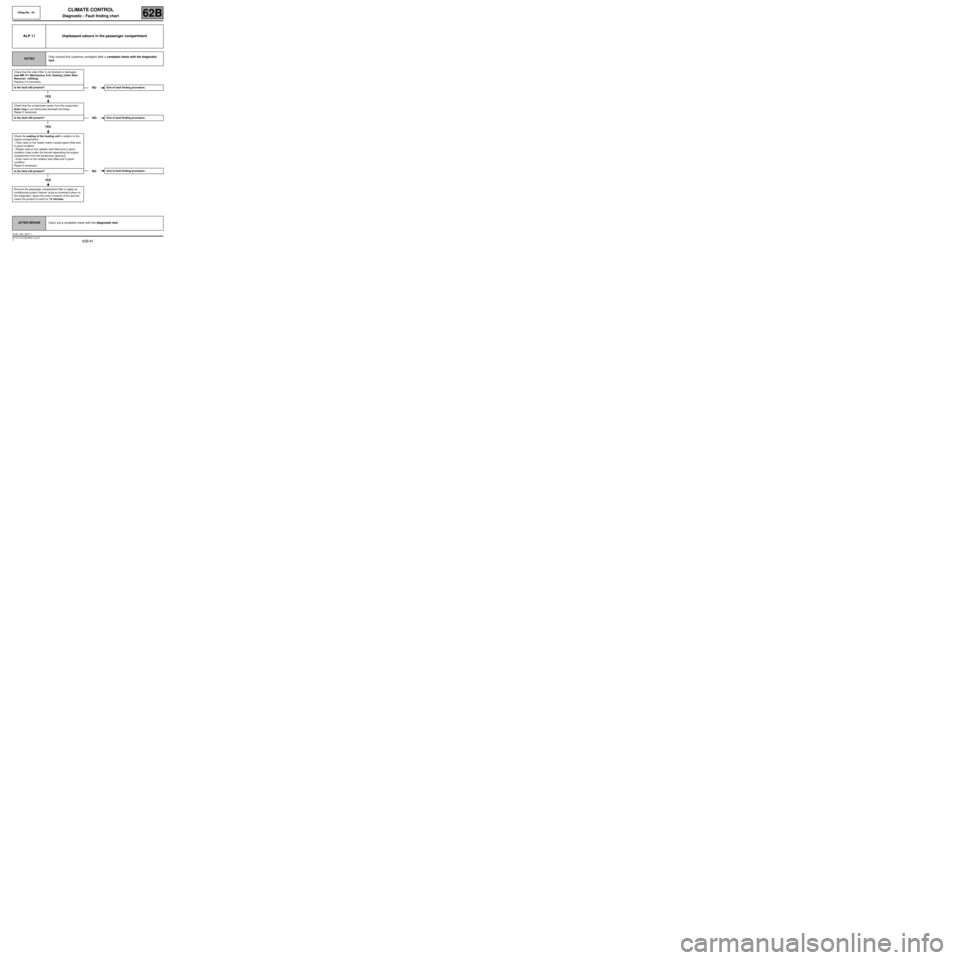
62B-91
MR-413-X44-62B000$920_eng.mif
V1
Vdiag No.: 44CLIMATE CONTROL
Diagnostic - Fault finding chart62B
ALP 11 Unpleasant odours in the passenger compartment
NOTESOnly consult this customer complaint after a complete check with the diagnostic
tool.
Check that the cabin filter is not blocked or damaged
(see MR 411 Mechanical, 61A, Heating, Cabin filter:
Removal - refitting).
Replace it if necessary.
Is the fault still present?
YES
Check that the condensate (water from the evaporator)
drain ring is not obstructed (beneath the body).
Repair if necessary.
Is the fault still present?
YES
Check the sealing of the heating unit in relation to the
engine compartment:
- Foam seal on the heater matrix coolant pipes fitted and
in good condition.
- Rubber seal on the radiator tank fitted and in good
condition (seal under the bonnet separating the engine
compartment from the windscreen aperture).
- Drain valve on the radiator tank fitted and in good
condition.
Repair if necessary.
Is the fault still present?
YES
Remove the passenger compartment filter to apply air
conditioning system cleaner using an extension piece on
the evaporator. Spray the entire contents of the aerosol.
Leave the product to work for 15 minutes.
NOEnd of fault finding procedure.
NOEnd of fault finding procedure.
NOEnd of fault finding procedure.
AFTER REPAIRCarry out a complete check with the diagnostic tool.
CLIM_V44_ALP11
Page 92 of 99
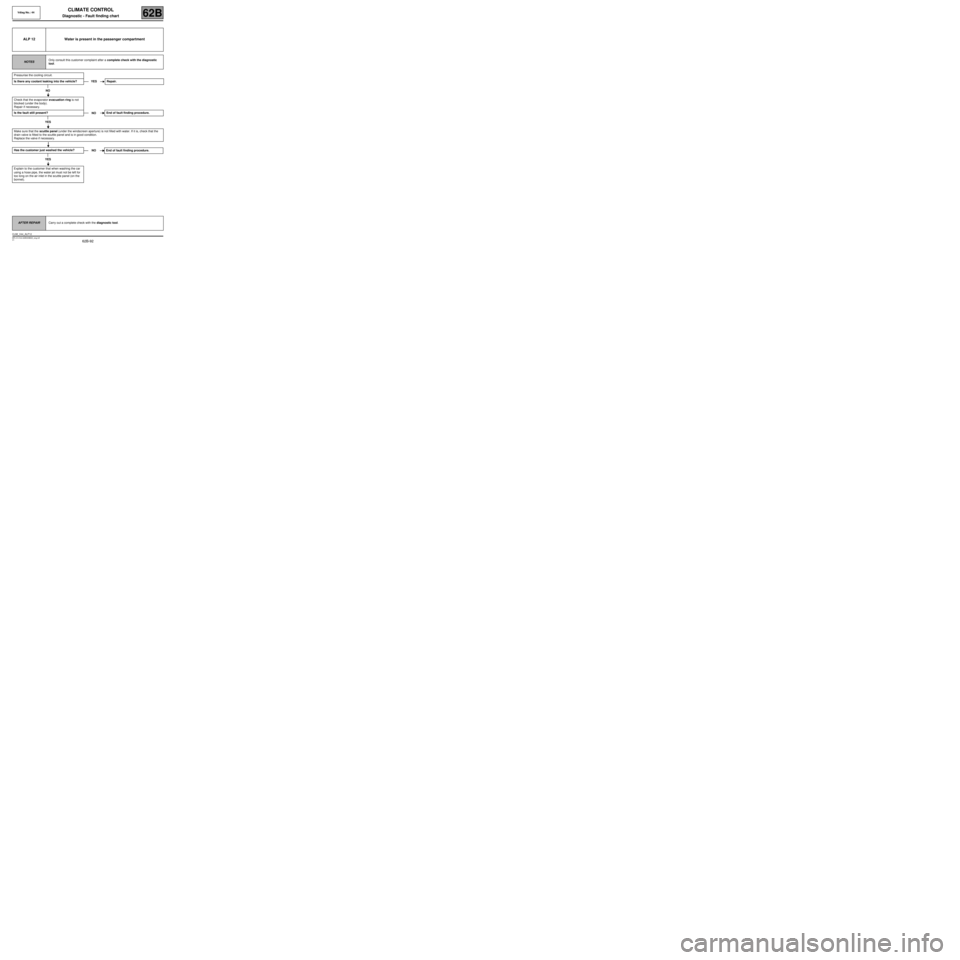
62B-92
MR-413-X44-62B000$920_eng.mif
V1
Vdiag No.: 44CLIMATE CONTROL
Diagnostic - Fault finding chart62B
ALP 12 Water is present in the passenger compartment
NOTESOnly consult this customer complaint after a complete check with the diagnostic
tool.
Pressurise the cooling circuit.
Is there any coolant leaking into the vehicle?
NO
Check that the evaporator evacuation ring is not
blocked (under the body).
Repair if necessary.
Is the fault still present?
YES
Make sure that the scuttle panel (under the windscreen aperture) is not filled with water. If it is, check that the
drain valve is fitted to the scuttle panel and is in good condition.
Replace the valve if necessary.
Has the customer just washed the vehicle?
YES
Explain to the customer that when washing the car
using a hose pipe, the water jet must not be left for
too long on the air inlet in the scuttle panel (on the
bonnet).
YES Repair.
NOEnd of fault finding procedure.
NO End of fault finding procedure.
AFTER REPAIRCarry out a complete check with the diagnostic tool.
CLIM_V44_ALP12
Page 93 of 99
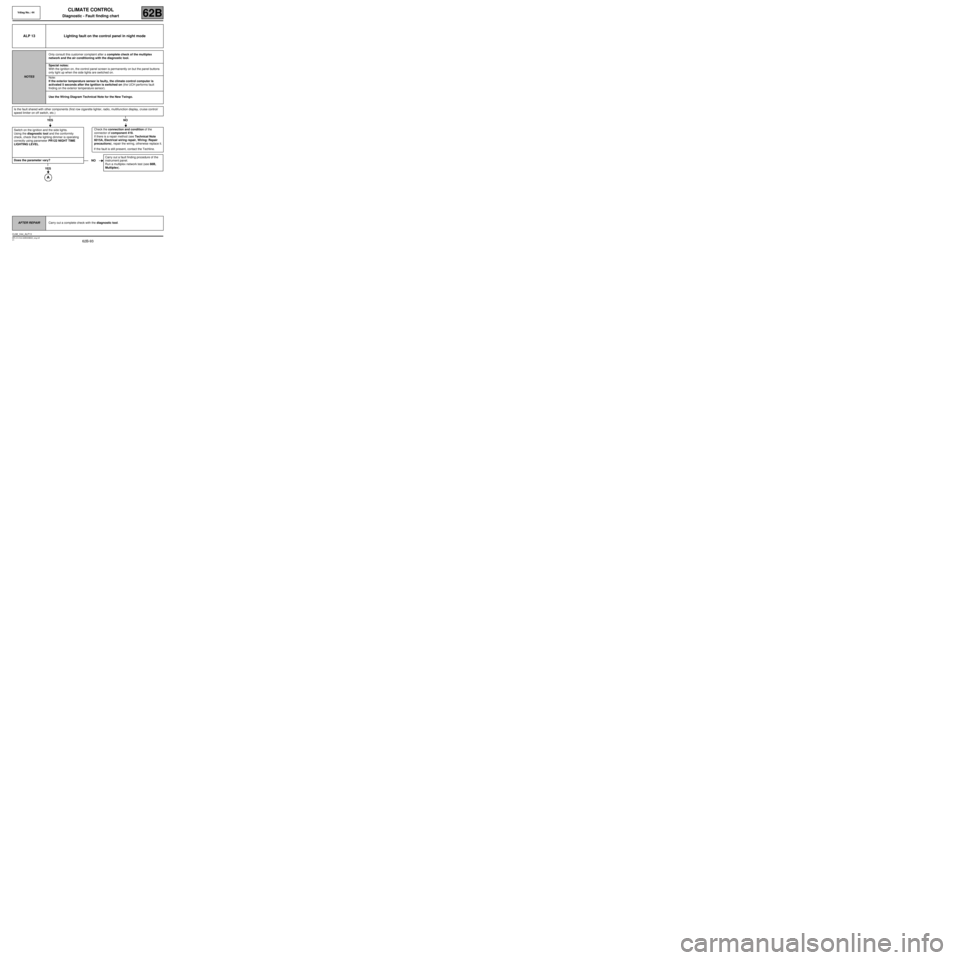
62B-93
MR-413-X44-62B000$920_eng.mif
V1
Vdiag No.: 44CLIMATE CONTROL
Diagnostic - Fault finding chart62B
ALP 13 Lighting fault on the control panel in night mode
NOTESOnly consult this customer complaint after a complete check of the multiplex
network and the air conditioning with the diagnostic tool.
Special notes:
With the ignition on, the control panel screen is permanently on but the panel buttons
only light up when the side lights are switched on.
Note:
If the exterior temperature sensor is faulty, the climate control computer is
activated 5 seconds after the ignition is switched on (the UCH performs fault
finding on the exterior temperature sensor).
Use the Wiring Diagram Technical Note for the New Twingo.
Is the fault shared with other components (first row cigarette lighter, radio, multifunction display, cruise control/
speed limiter on off switch, etc.)
YES NO
Switch on the ignition and the side lights.
Using the diagnostic tool and the conformity
check, check that the lighting dimmer is operating
correctly using parameter PR122 NIGHT TIME
LIGHTING LEVEL.
Does the parameter vary?
YES
Check the connection and condition of the
connector of component 419.
If there is a repair method (see Technical Note
6015A, Electrical wiring repair, Wiring: Repair
precautions), repair the wiring, otherwise replace it.
If the fault is still present, contact the Techline.
NOCarry out a fault finding procedure of the
instrument panel.
Run a multiplex network test (see 88B,
Multiplex).
AFTER REPAIRCarry out a complete check with the diagnostic tool.
CLIM_V44_ALP13
Page 94 of 99
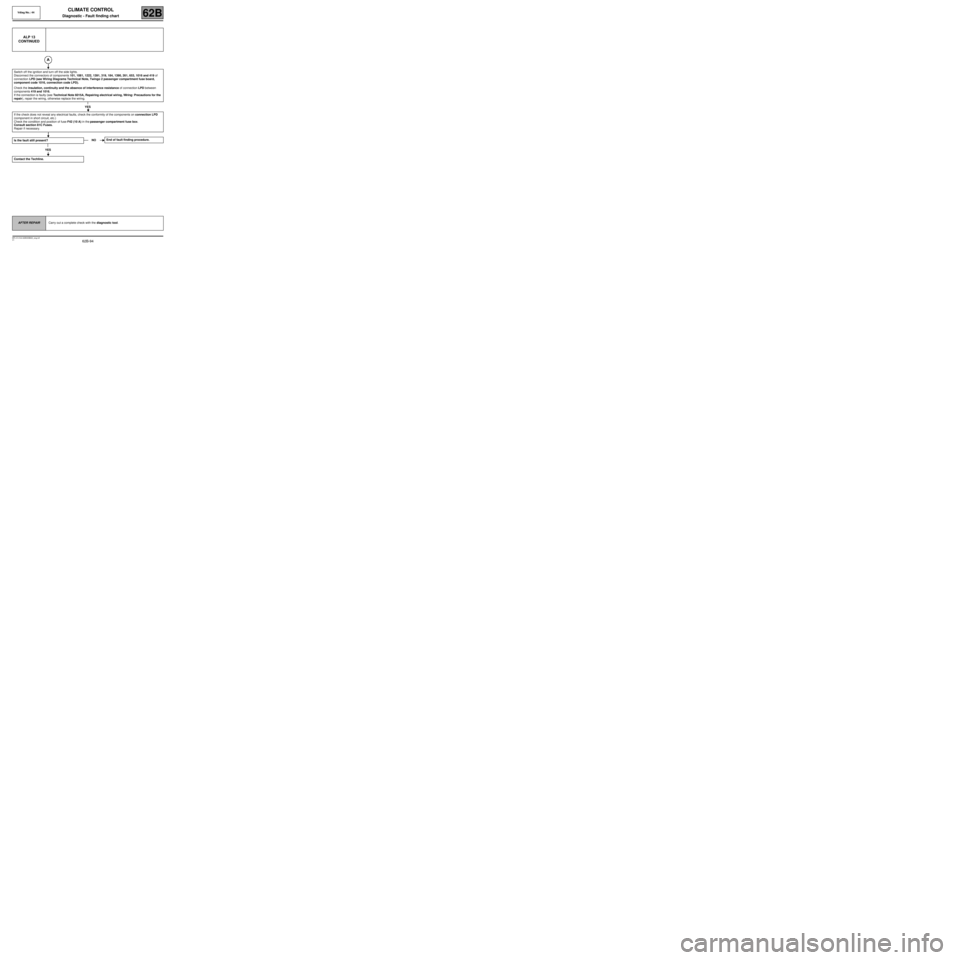
62B-94
MR-413-X44-62B000$920_eng.mif
V1
Vdiag No.: 44CLIMATE CONTROL
Diagnostic - Fault finding chart62B
ALP 13
CONTINUED
Switch off the ignition and turn off the side lights.
Disconnect the connectors of components 101, 1081, 1222, 1391, 319, 184, 1390, 261, 653, 1016 and 419 of
connection LPD (see Wiring Diagrams Technical Note, Twingo 2 passenger compartment fuse board,
component code 1016, connection code LPD).
Check the insulation, continuity and the absence of interference resistance of connection LPD between
components 419 and 1016.
If the connection is faulty (see Technical Note 6015A, Repairing electrical wiring, Wiring: Precautions for the
repair), repair the wiring, otherwise replace the wiring.
YES
If the check does not reveal any electrical faults, check the conformity of the components on connection LPD
(component in short circuit, etc.)
Check the condition and position of fuse F42 (10 A) in the passenger compartment fuse box.
Consult section 81C Fuses.
Repair if necessary.
Is the fault still present?
YES
Contact the Techline.
NOEnd of fault finding procedure.
AFTER REPAIRCarry out a complete check with the diagnostic tool.
Page 95 of 99
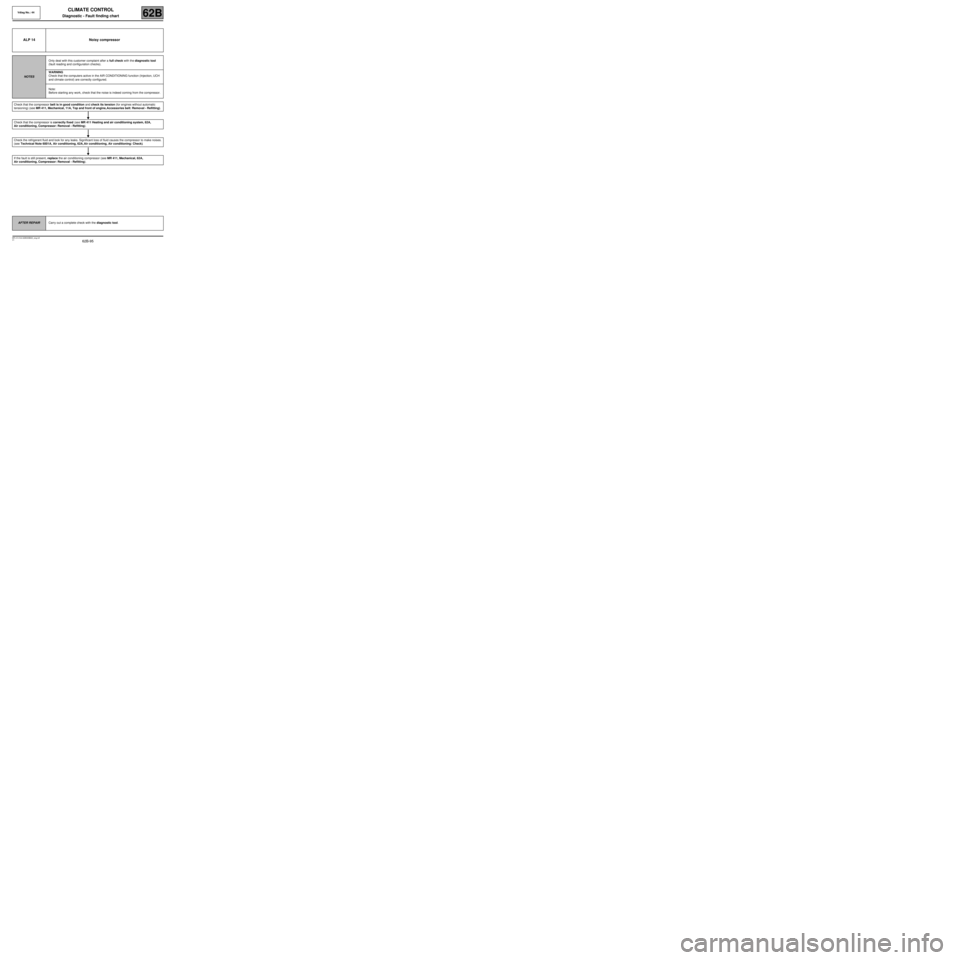
62B-95
MR-413-X44-62B000$920_eng.mif
V1
CLIMATE CONTROL
Diagnostic - Fault finding chart
Vdiag No.: 44
62B
ALP 14 Noisy compressor
NOTESOnly deal with this customer complaint after a full check with the diagnostic tool
(fault reading and configuration checks).
WARNING
Check that the computers active in the AIR CONDITIONING function (Injection, UCH
and climate control) are correctly configured.
Note:
Before starting any work, check that the noise is indeed coming from the compressor.
Check that the compressor belt is in good condition and check its tension (for engines without automatic
tensioning) (see MR 411, Mechanical, 11A, Top and front of engine, Accessories belt: Removal - Refitting).
Check that the compressor is correctly fixed (see MR 411 Heating and air conditioning system, 62A,
Air conditioning, Compressor: Removal - Refitting).
Check the refrigerant fluid and look for any leaks. Significant loss of fluid causes the compressor to make noises.
(see Technical Note 6001A, Air conditioning, 62A, Air conditioning, Air conditioning: Check).
If the fault is still present, replace the air conditioning compressor (see MR 411, Mechanical, 62A,
Air conditioning, Compressor: Removal - Refitting).
AFTER REPAIRCarry out a complete check with the diagnostic tool.
Page 99 of 99
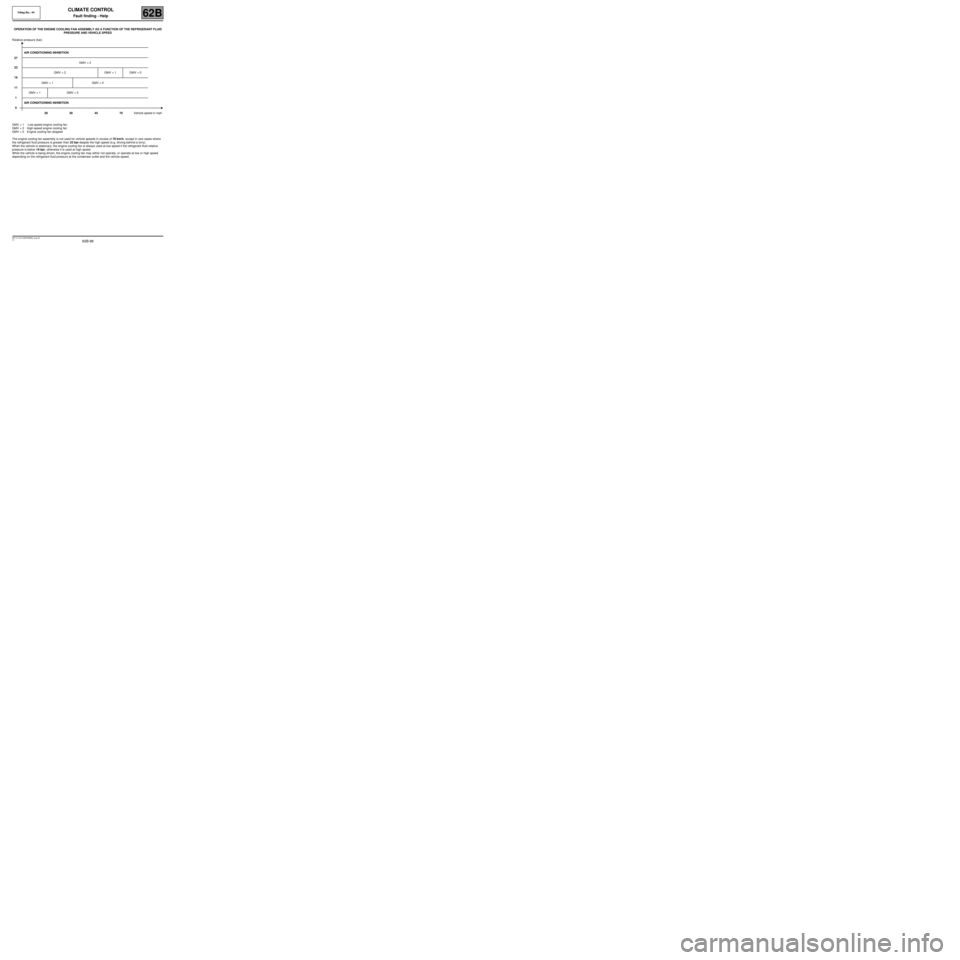
62B-99
MR-413-X44-62B000$966_eng.mif
V1
CLIMATE CONTROL
Fault finding - Help
Vdiag No.: 44
62B
OPERATION OF THE ENGINE COOLING FAN ASSEMBLY AS A FUNCTION OF THE REFRIGERANT FLUID
PRESSURE AND VEHICLE SPEED
Relative pressure (bar)
GMV = 1 Low-speed engine cooling fan
GMV = 2 High-speed engine cooling fan
GMV = 0 Engine cooling fan stopped
The engine cooling fan assembly is not used for vehicle speeds in excess of 70 km/h, except in rare cases where
the refrigerant fluid pressure is greater than 23 bar despite the high speed (e.g. driving behind a lorry).
When the vehicle is stationary, the engine cooling fan is always used at low speed if the refrigerant fluid relative
pressure is below 19 bar, otherwise it is used at high speed.
While the vehicle is being driven, the engine cooling fan may either not operate, or operate at low or high speed
depending on the refrigerant fluid pressure at the condenser outlet and the vehicle speed.27
23
19
11
1
0AIR CONDITIONING INHIBITION
GMV = 2
GMV = 2 GMV = 1 GMV = 0
GMV = 1 GMV = 0
GMV = 1 GMV = 0
AIR CONDITIONING INHIBITION
20 30 45 70Vehicle speed in mph